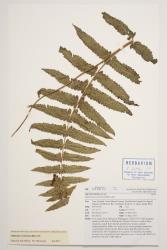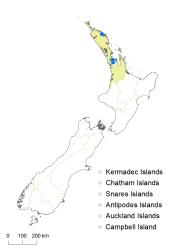- ≡ Hemionitis esculenta Retz., Observ. Bot. 6, 38 (1791)
- ≡ Asplenium esculentum (Retz.) C.Presl, Reliq. Haenk. 1, 45 (1825)
- ≡ Anisogonium esculentum (Retz.) C.Presl, Tent. Pterid. 116 (1836)
- ≡ Athyrium esculentum (Retz.) Copel., Philipp. J. Sci. 3: 295 (1908)
In New Zealand Diplazium esculentum has a short, erect rhizome with black, wiry roots that produce young plants from vegetative buds; fronds up to 500 mm long; yellow-brown stipes up to 270 mm long, becoming blackish proximally; laminae 1-pinnate-pinnatifid in juvenile fronds becoming 2-pinnate in mature fronds, ovate or broadly ovate, up to 320 mm long and 300 mm wide; the longest primary pinnae ovate or elliptic, 160 mm long, 75 mm wide, with a long pinnatifid terminal segment tapering to a sharp acuminate apex; secondary pinnae narrowly triangular, up to 40 mm long, 13 mm wide, with sharp acuminate apices, margins serrate, lobed proximally; veins anastomosing; abaxial lamina surface bearing pale brown scales and abundant glandular and non-glandular, multicellular, colourless or brownish hairs. The species has not yet been seen fertile in New Zealand, but it spreads vegetatively via an extensive underground network of black, wiry, easily detached roots that produce numerous young plants from vegetative buds.
North Island: Northland, Auckland.
Altitudinal range: 10–40 m.
Known from one locality in Kerikeri and two in Auckland.
Occurs naturally in India, Malaysia, China, Taiwan, Indonesia, Philippines, Papua New Guinea, Solomon Islands, and Vanuatu. Naturalised in southern Africa (Roux 2009), Queensland (Jones 1998), Hawai‘i (Palmer 2003), south-east USA (Smith 1993).
Recorded as a cultivation escape, initially from a garden in Kerikeri, where the species had spread rapidly and aggressively. It has also been collected from flood-deposited material washed downstream from plantings at Puhinui Creek, and from a possible past deliberate planting at Glendowie, both in Auckland.
New record. Voucher AK 259023-24, WELT P022986, CHR 546537, 2002.
Diplazium esculentum (Retz.) Sw. is a widespread species in tropical and subtropical Asia and the western Pacific, often used for culinary and ornamental purposes. Parris noted (label data, AK 259023 and WELT P022986) that Diplazium esculentum was sold in New Zealand garden centres in the early 1990s as Thelypteris ‘Mexico’. Because it was an invasive weed of open situations, she recommended that it should not be cultivated in New Zealand, noting that it was capable of colonising riverbanks at an average rate of spread of 1 m per year.





